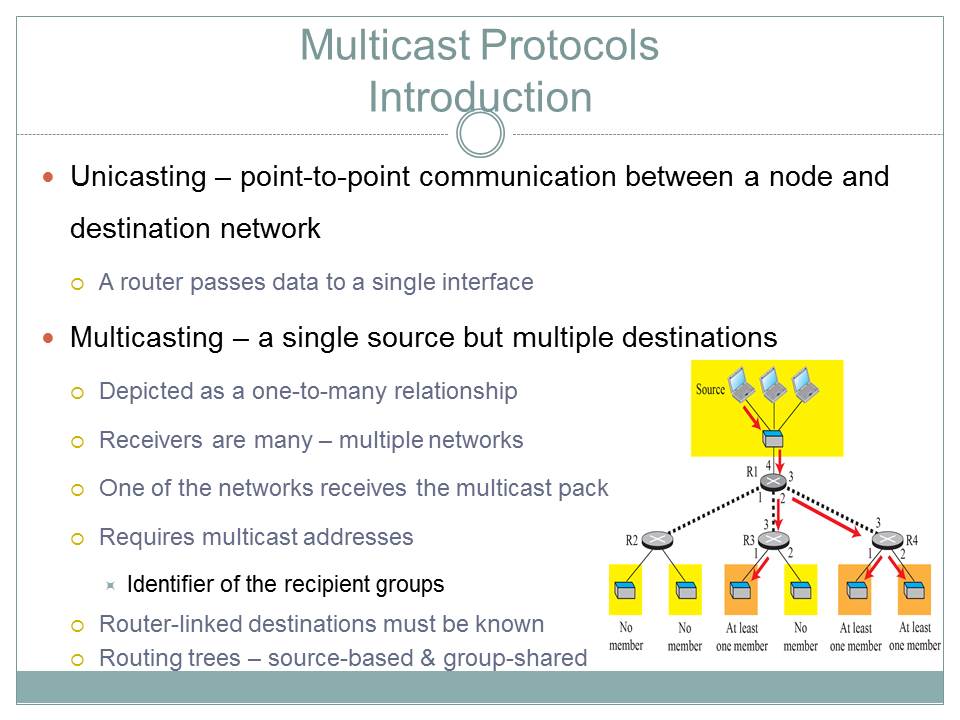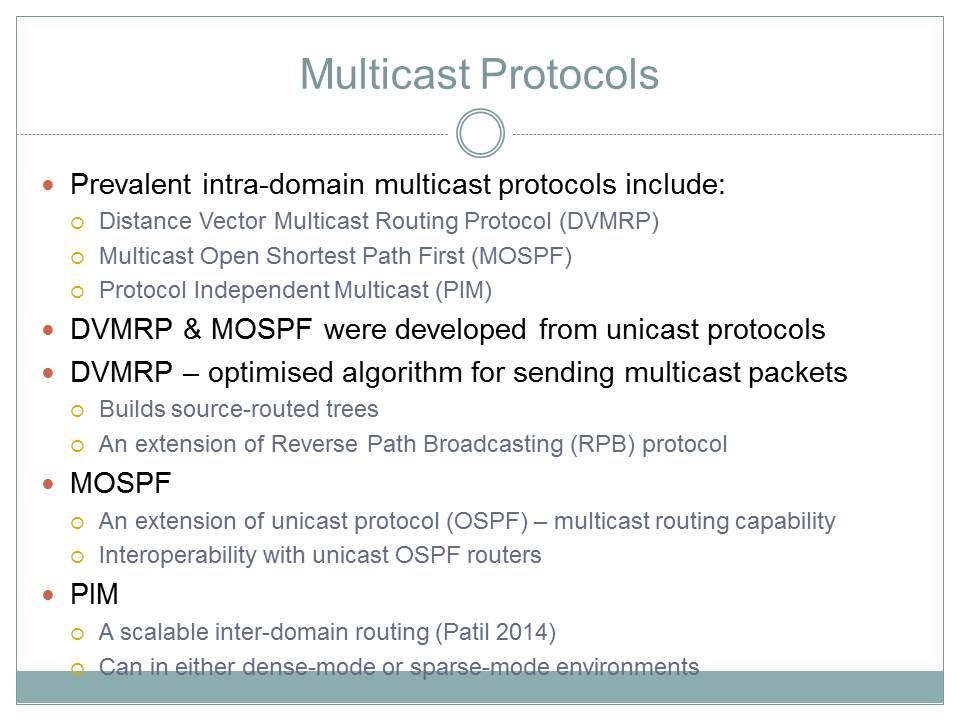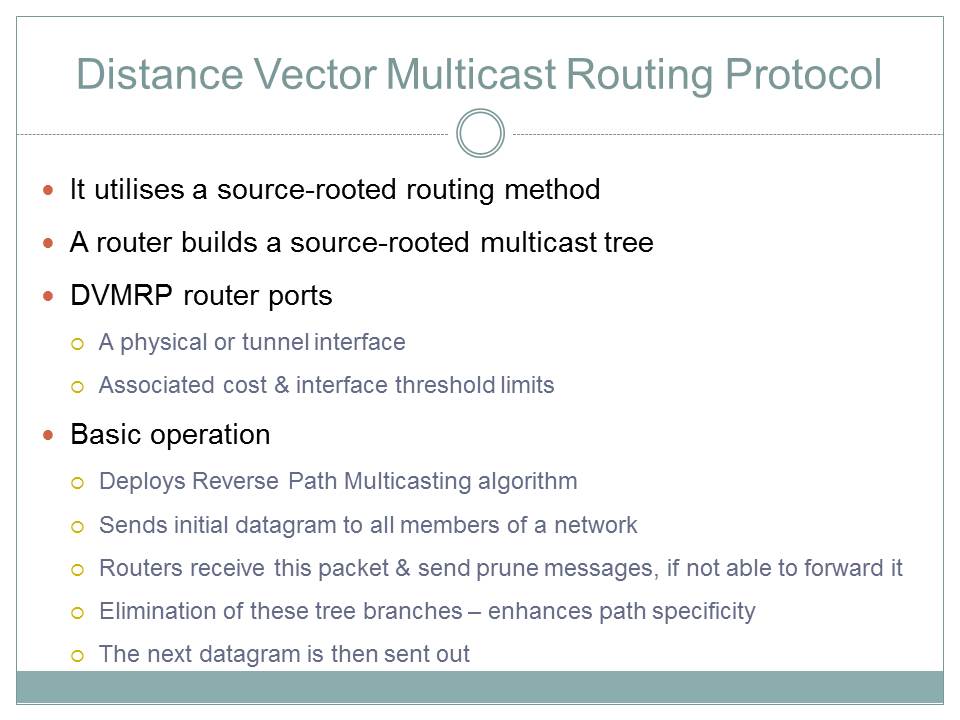Multicast Protocols Introduction
Unicasting – point-to-point communication between a node and destination network:
- A router passes data to a single interface.
Multicasting – a single source but multiple destinations:
- Depicted as a one-to-many relationship;
- Receivers are many – multiple networks;
- One of the networks receives the multicast packet;
- Requires multicast addresses:
- Identifier of the recipient groups.
- Router-linked destinations must be known;
- Routing trees – source-based & group-shared.
Unicasting differs from multicasting in terms of the source and number of recipient networks. While in unicasting the relationship between the two is unilateral, in multicasting, a router would pass a datagram to multiple recipients identified in a group address (Patil 2014). Therefore, the data packet is sent to many receivers with the interested network picking up the information. Since in unicasting not all addresses can be included the datagram, only one destination (Internet Protocol or IP) is defined (Patil 2014). In multicasting, multiple addresses are included to identify the destinations for the data packet. Hosts can move between multicast groups to receive a datagram of interest at any time. In this case, there is no limit to the location or number of hosts and a receiver can belong to many groups simultaneously. Furthermore, messages from other hosts can be forwarded to a group. Multicast routing requires that a router knows the recipients linked to it (Patil 2014). Additionally, data received is sent out to all routers in a network simultaneously to determine the destination of each member. Routing trees are required to optimise the transmission process of the packet. Two routing methods can be used: source-based and group-shared distribution trees (Patil 2014). In the source-based approach, a single source-group pair tree is created to distribute the packet. Thus, this transmission is unidirectional. In contrast, in group-shared method, routers build a per-group tree for all the members of the network (Patil 2014). In this regard, this approach can be bidirectional.

Multicast Protocols
Prevalent intra-domain multicast protocols include:
- Distance Vector Multicast Routing Protocol (DVMRP);
- Multicast Open Shortest Path First (MOSPF);
- Protocol Independent Multicast (PIM);
DVMRP & MOSPF were developed from unicast protocols.
DVMRP – optimised algorithm for sending multicast packets:
- Builds source-routed trees;
- An extension of Reverse Path Broadcasting (RPB) protocol.
MOSPF:
- An extension of unicast protocol (OSPF) – multicast routing capability;
- Interoperability with unicast OSPF routers.
PIM:
- A scalable inter-domain routing (Patil 2014);
- Can in either dense-mode or sparse-mode environments.
Three most common branches of multicast protocols used in intra-domain routing are Distance Vector Multicast Routing Protocol (DVMRP), Multicast Open Shortest Path First (MOSPF) and Protocol Independent Multicast (PIM). The first two enhance existing unicast routing by providing the capability to send multicast datagrams. The DVMRP can support multicasting through a network. It builds source-routed trees to deliver datagrams, and it has been implemented in most Multicast Backbone (MBONE) routers (Patil 2014). It is a multicast variant of the Routing Information Protocol (RIP), unicast routing approach. The DVMRP algorithm traces the path back to the source. The aim is to ensure quick and efficient route computation and traffic management. The MOSPF protocol is an extension of the OSPF. It uses the OSPF network topology but includes the capability to transmit multicast datagrams (Patil 2014). A key improvement that has been added to MOSPF include backward compatibility, which supports interoperability of MOSPF routers. Thus, MOSPF can route unicast data through a network. The PIM protocol offers “scalable inter-domain routing across the Internet” (Patil 2014, p. 6345). This approach still relies on unicasting primarily to create a routing table information. PIM can work in dense-mode or sparse-mode contexts. In the first case, the protocol runs in an environment with many hosts connected to a network. In contrast, in the sparse-mode approach, PIM is optimised to operate in dispersed nodes located in different areas. All multicast protocols build delivery trees to facilitate packet transmission across routers. They utilise different algorithms to construct trees and determine the shortest path for forwarding messages. They include flooding, spanning trees, reverse broadcasting, truncated reverse path broadcasting, and reverse path multicasting (Patil 2014). These algorithms are implemented in the three multicast protocols described above to construct trees and deliver packets and reconstruct pruned branches.

Distance Vector Multicast Routing Protocol
It utilises a source-rooted routing method.
A router builds a source-rooted multicast tree.
DVMRP router ports:
- A physical or tunnel interface;
- Associated cost & interface threshold limits.
Basic operation:
- Deploys Reverse Path Multicasting algorithm;
- Sends initial datagram to all members of a network;
- Routers receive this packet & send prune messages, if not able to forward it;
- Elimination of these tree branches – enhances path specificity;
- The next datagram is then sent out.
A DVMRP router is a source-based protocol. The algorithm buil.ds source-rooted trees to optimise the transmission path through a network. The DVMRP router’s ports may be a “physical interface” linked to a network or a “tunnel interface connected to another multicast island” (Patil 2014, 6345). They specify the associated cost of transmission and threshold limits that restricts the amount of multicast datagram that can be transmitted by the router. Additionally, the tunnel interface requires that the IP addresses of the sender and recipient are specified (Patil 2014). DVMRP is based on the Routing Information Protocol that is deployed in unicasting. The operation of the DVMRP algorithm entails a few steps. First, the initial packet from a source is passed to all the nodes connected to a network. The datagram sent specifies the cost and threshold limits to the receivers. Leaf routers receiving this information may respond with “prune messages” to the source when none of them is connected to a specified subnetwork (Patil 2014, p. 6346). As a result, the branches responding with prune messages are eliminated from the tree for rapid path calculation and identification. After some time, the pruned branches develop again in readiness for the next message. Therefore, this approach uses a mechanism that restores a removed branch to its tree soon after the message has been delivered. When a router that gave out a prune message finds a new recipient in a network, it forwards the datagram to the previous router (Patil 2014). In this regard, an upstream router receiving this information can pass it back to the source to initiate the transmission process afresh. This approach allows pruned branches to develop again on a multicast tree.

Multicast Open Shortest Path First (MOSPF)
Source-rooted tree algorithm.
Extends unicasting to multicasting:
- Every router is linked to a database;
- Aim: to determine an interface with an active node.
Uses intra-area routing:
- All receivers must be one OSPF area – local group database;
- Router delivers datagrams to these members.
A designated router is used to:
- Transmit host membership queries;
- Listen to membership reports.
Shortest path tree:
- Created on-demand upon receiving the initial message.
MOSPF uses the shortest path first based on the source-rooted tree method (Patil 2014). The MOSPF algorithm requires that all routers are connected to a local database, which is determined using the distance-vector approach. Intra-area routing facilitates multicasting only when the source and recipients are located in the same region (Patil 2014). Alternatively, if an autonomous system is limited to a given location, the MOSPF algorithm can be used to send multicast datagrams across the network. Its operation entails monitoring of membership linked to networks by utilising the Internet Group Management Protocol (IGMP) (Patil 2014). Nodes belonging to a local group database are the recipients of multicast messages. A designated router (DR) transmits queries and listens to IGMP host reports to determine the shortest path tree (Patil 2014). Therefore, one MOSPF router must be identified as the DR for a given network. A router priority of zero is assigned to routers that are not DRs. The shortest path is determined based on the on-demand messages received by the DR from a given source.

Reference List
Patil, MB 2014, ‘Multicast routing and its protocols’, International Journal of Computer Science and Information Technologies, vol. 5, no. 5, pp. 6345-6349.